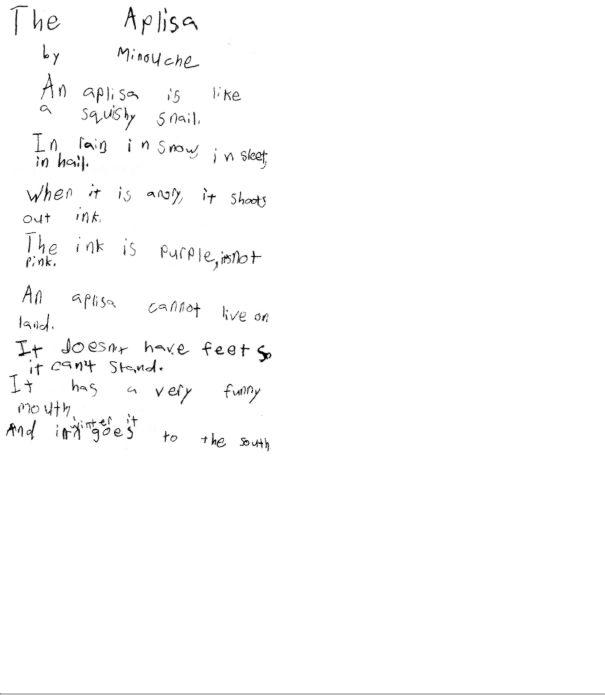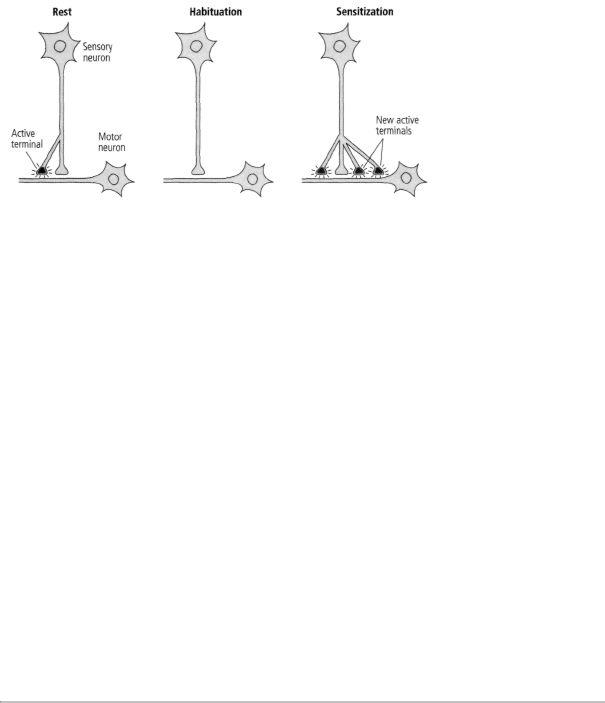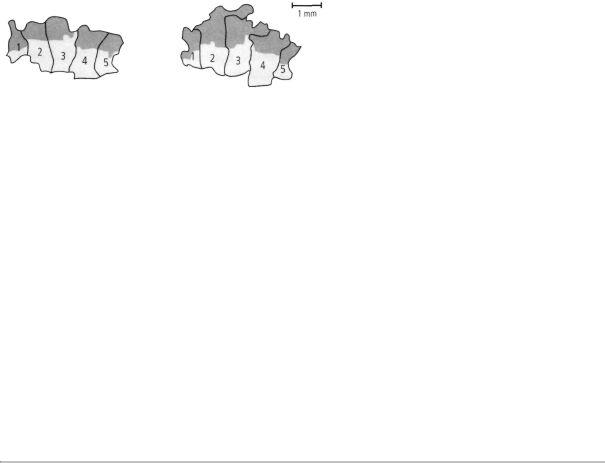
Erik_Kandel_-_V_poiskakh_pamyati_angl
.pdf
(Reprinted from Behavioral Biology of Aplysia, E. R. Kandel, W. H. Freeman and Company, 1979.)
One of the fundamental features of memory is that it is formed in stages. Short-term memory lasts minutes, while long-term memory lasts many days or even longer. Behavioral experiments suggest that short-term memory grades naturally into long-term memory and, moreover, that it does so through repetition. Practice does make perfect.
How does practice do it? How does training convert a short-term memory into a persistent, selfmaintained long-term memory? Does the process take place at the same site—the connection between the sensory and motor cells—or is a new site required? We were now in a position to answer those questions.
In this period, science was again claiming my total concentration, to the exclusion of other activities. In my obsession with Aplysia, however, I found an unexpected ally in my daughter, Minouche. In 1970, at age five, as Minouche started to read, she stumbled on a picture of Aplysia in The Larousse Encyclopedia of Animal Life, a beautiful picture book that I kept in our living room. She simply loved the picture and would squeal, "Aplysia! Aplysia!" over and over again, pointing to the picture.
Two years later, at the age of seven, she wrote the following poem on the occasion of my forty-third birthday:
The Aplisa
by Minouche

An aplisa is like a squishy snail.
In rain, in snow, in sleet, in hail.
When it is angry, it shoots out ink.
The ink is purple, it's not pink.
An aplisa cannot live on land.
It doesn't have feet so it can't stand.
It has a very funny mouth.
And in winter it goes to the south.
Minouche said it all, much better than I could!
15
THE BIOLOGICAL BASIS OF INDIVIDUALITY
I had learned from my research in Aplysia that changes in behavior are accompanied by changes in the strength of the synapses between neurons that produce the behavior. But nothing in my research revealed how short-term memory is transformed into long-term memory. Indeed, nothing was known about the cellular mechanisms of long-term memory.
The basis for my early research in learning and memory was the learning paradigms used by behaviorists. The behaviorists focused primarily on how knowledge was acquired and stored in short-term memory. Long-term memory did not particularly interest them. The interest in long-term memory came from studies of human memory by the forerunners of cognitive psychologists.
IN 1885, A DECADE BEFORE EDWARD THORNDIKE BEGAN HIS
studies of learning in experimental animals at Columbia University, the German philosopher Hermann Ebbinghaus transformed the analysis of human memory from an introspective study into a laboratory science.

Ebbinghaus was influenced by three scientists—the physiologist Ernst Weber, and the physicists Gustav Fechner and Hermann Helmholtz—who introduced rigorous methods to the study of percep-
tion. Helmholtz, for example, measured the speed at which a touch on the skin travels to the brain. It was generally thought at the time that conduction along nerves was immeasurably fast, comparable to the speed of light. But Helmholtz found it to be slow—about 90 feet per second. Moreover, the time it took a subject to react to the stimulus—the reaction time—was even slower! This caused Helmholtz to propose that a considerable amount of the brain's processing of perceptual information is carried out unconsciously. He called this processing "unconscious inference" and proposed that it was based on evaluating and transforming the neural signal without conscious awareness of doing so. This processing, he argued, must result from signals being routed and processed at different sites during perception and voluntary movement.
Like Helmholtz, Ebbinghaus held the position that mental processes are biological in nature and can be understood in the same rigorous scientific terms as physics and chemistry. Perception, for example, can be studied empirically as long as the sensory stimuli used to elicit responses are objective and quantifiable. Ebbinghaus conceived the idea of studying memory by means of a similar experimental approach. The techniques he devised for measuring memory are still in use today.
In devising his experiments on how new information is put into memory, Ebbinghaus had to be certain that the people he studied were forming new associations, not relying for help on associations learned earlier. He hit upon the idea of having subjects learn nonsense words, each consisting of two consonants separated by a vowel (RAX, PAF, WUX, CAZ, and so on). Because each word is meaningless, it does not fit into the learner's preestablished network of associations. Ebbinghaus made up about 2000 such words, wrote each on a separate slip of paper, shuffled the slips, and randomly drew slips to create lists that varied in length between 7 and 36 nonsense words. Faced with the arduous task of memorizing the lists, he went to Paris and rented a room in a garret overlooking the roofs of that beautiful city. There, he memorized each list in turn by reading it aloud at the rate of 50 words per minute. As Denise would say, "Only in Paris can one even think of doing such a boring experiment!"
From these self-inflicted experiments, Ebbinghaus generated two principles. First, he found that memory is graded—in other words,
practice makes perfect. There was a linear relationship between the number of training repetitions on the first day and the amount of material retained on the following day. Long-term memory therefore appeared to be a simple extension of short-term memory. Second, despite the apparent similarity in mechanism between shortand long-term memory, Ebbinghaus noted that a list of six or seven items could be learned and retained in only one presentation, whereas a longer list required repeated presentations.
Next, he plotted a forgetting curve. He tested himself at various intervals after learning, using different lists for each interval, and determined the amount of time it took to relearn each list with the same degree of accuracy as in the first learning. He found that there were savings: relearning an old list took less time and fewer trials than the original learning. Most interesting of all, he found that forgetting had at least two phases: a rapid initial decline that was sharpest in the first hour after learning and then a much more gradual decline that continued for about a month.
Based on Ebbinghaus's two phases of forgetting and on his own remarkable intuition, William James concluded in 1890 that memory must have at least two different processes: a short-term process, which he called "primary memory," and a long-term process, which he called "secondary memory." He referred to long-term memory as secondary because it involved recalling memory some time after a primary learning event.
IT GRADUALLY BECAME CLEAR TO THE PSYCHOLOGISTS WHO
followed Ebbinghaus and James that the next step in understanding long-term memory was to understand how it becomes firmly established, a process now called consolidation. For a memory to persist, the incoming

information must be thoroughly and deeply processed. This is accomplished by attending to the information and associating it meaningfully and systematically with knowledge already well established in memory.
The first clue that newly stored information is made more stable for long-term storage came in 1900 from two German psychologists, Georg Müller and Alfons Pilzecker. Using Ebbinghaus's techniques,
they asked a group of volunteers to learn a list of nonsense words well enough to remember them twenty-four hours later, which the group did readily. They then asked a second group to learn the same list with the same number of repetitions, but they gave the second group an additional list of words to learn immediately after learning the first list. This second group of volunteers failed to remember the first list twenty-four hours later. In contrast, a third group of volunteers, who were given the second list two hours after having learned the first list, had little difficulty remembering the first list twentyfour hours later. This result suggested that in the hour after training, when the initial list had been placed into short-term memory and perhaps even into the early stages of long-term memory, memory was still sensitive to disruption. Presumably, a certain amount of time was required for long-term memory to become fixed, or consolidated. Once consolidated, after two or more hours, it was stable for some time and less easily disrupted.
The idea of memory consolidation is supported by two types of clinical observations. First, it has been known since the end of the nineteenth century that head injuries and concussion can lead to a memory loss called retrograde amnesia. A boxer who is hit on the head and sustains a brain concussion in round five of a match will usually remember going to the event, but everything after that will be blank. Undoubtedly, a number of events entered into his short-term memory just before the blow—the excitement of entering the ring, his opponent's movements during the earlier four rounds, perhaps even the moving punch itself and the attempt to avoid it—but the blow to the brain occurred before any of those memory traces could be consolidated. The second clinical observation is that a similar retrograde amnesia often occurs following an epileptic convulsion. People with epilepsy cannot remember events immediately preceding a seizure, even though the seizure has no effect on their memory of earlier events. This suggests that in its early phases memory storage is dynamic and sensitive to disruption.
The first rigorous test of memory consolidation came in 1949, when the American psychologist C. P. Duncan applied electrical stimuli to the brain of animals during or immediately after training, resulting in convulsions that disrupted memory and caused retrograde
amnesia. Producing seizures several hours after training had little or no effect on recall. Almost twenty years later, Louis Flexner at the University of Pennsylvania made the remarkable discovery that drugs that inhibit the synthesis of proteins in the brain disrupt long-term memory if given during and shortly after learning, but they do not disrupt short-term memory. This finding suggested that long-term memory storage requires the synthesis of new proteins. Together, the two sets of studies seemed to confirm the idea that memory storage takes place in at least two stages: a short-term memory lasting minutes is converted—by a process of consolidation that requires the synthesis of new protein—into stable, long-term memory lasting days, weeks, or even longer.
Variants of the two-stage model of memory were soon proposed. According to one view, shortand long-term memory take place at different anatomical sites. Alternatively, some psychologists argued that memory was present at one site and simply became progressively stronger with time. The question of whether shortand long-term memory require two separate sites or can be accommodated at one site is central to the analysis of learning, particularly to the analysis of memory on the cellular level. Clearly, it could not be resolved with behavioral analyses alone—cellular analysis was needed. Our

studies of Aplysia had put us in a position to tackle the question of whether shortand long-term memory are the same or separate neural processes occurring at the same or different sites.
CAREW AND I HAD FOUND IN 1971 THAT, WITH REPEATED TRAINING,
habituation and sensitization—the simplest forms of learning—can be sustained for long periods. Thus they could serve as useful tests for differences between long-term and short-term memory. We eventually discovered that the cellular changes accompanying long-term sensitization in Aplysia were similar to changes underlying long-term memory in the mammalian brain: long-term memory required the synthesis of new protein.
We wanted to know whether simple forms of long-term memory use the same storage sites—the same group of neurons and the same set of synapses—as short-term memory. I knew from the work of
Brenda Milner on H.M. that, in people, complex, explicit long-term memory—a memory lasting days to years— requires not only the cortex but also the hippocampus. But what about the simpler impUcit memory? Carew, Castellucci, and I found that the same synaptic connections between sensory and motor neurons that are altered in short-term habituation and sensitization are also altered in long-term habituation and sensitization. Moreover, in both cases, the synaptic changes parallel the changes in behavior we observed: in long-term habituation, the synapse is depressed for a period of weeks, whereas in long-term sensitization, it is enhanced for weeks. This suggested that, in the simplest cases, the same site can store both shortand long-term memory and that it can do so for different forms of learning.
That left the question of mechanism. Are the mechanisms of short-term and long-term memory the same? If so, what is the nature of the process by which long-term memory is consolidated? Is protein synthesis needed for the long-term synaptic changes associated with long-term memory storage?
I had thought for some time that long-term memory might be consolidated by an anatomical change. Such a change might be one of the reasons that new protein is needed. I sensed that we would soon require an analysis of the structure of memory storage. In 1973 I succeeded in recruiting Craig Bailey, a talented and creative young cell biologist, to explore the structural changes that accompany the transition from shortto long-term memory.
Bailey and his colleague, Mary Chen, and Carew and I found that long-term memory is not simply an extension of short-term memory: not only do the changes in synaptic strength last longer but, more amazingly, the actual number of synapses in the circuit changes. Specifically, in long-term habituation the number of presynaptic connections among sensory neurons and motor neurons decreases, whereas in long-term sensitization sensory neurons grow new connections that persist as long as the memory is retained (figure 15-1). There is in each case a parallel set of changes in the motor cell.
This anatomical change is expressed in several ways. Bailey and Chen found that a single sensory neuron has approximately 1300 presynaptic terminals with which it contacts about 25 different target

At rest, this sensory neuron has two points of contact with a motor neuron.
nal, leading to an almost complete shutdown of synaptic transmission.
Long-term habituation |
Long-term sensitization causes |
causes the sensory neuron |
the sensory neuron to grow |
to retract its active termi- |
new terminals and to make |
more active contacts with the |
|
motor neuron. This increases |
|
synaptic transmission. |
|
15-1 Anatomical changes accompany long-term memory.
cells—motor neurons, excitatory interneurons, and inhibitory interneurons. Of the 1300 presynaptic terminals, only about 40 percent have active synapses, and only these synapses have the machinery for releasing a neurotransmitter. The remaining terminals are dormant. In long-term sensitization, the number of synaptic terminals more than doubles (from 1300 to 2700), and the proportion of active synapses increases from 40 percent to 60 percent. In addition, there is an outgrowth from the motor neuron to receive some of the new connections. In time, as the memory fades and the enhanced response returns to normal, the number of presynaptic terminals drops from 2700 to about 1500, or slightly more than the initial number. This residual growth presumably is responsible for the fact, first discovered by Ebbinghaus, that an animal can learn a task more readily a second time. In long-term habituation, on the other hand, the number of presynaptic terminals drops from 1300 to about 850, and the number of active terminals diminishes from 500 to about 100—an almost complete shutdown of synaptic transmission (figure 15-1).
Thus in Aplysia we could see for the first time that the number of
synapses in the brain is not fixed—it changes with learning! Moreover, long-term memory persists for as long as the anatomical changes are maintained.
These studies provided the first clear insights into the two competing theories of memory storage. Both were right, but in different ways. Consistent with the one-process theory, the same site can give rise to both short-term and long-term memory in habituation and sensitization. Moreover, in each case a change in synaptic strength occurs. But consistent with the two-process theory, the mechanisms of shortand long-term change are fundamentally different. Short-term memory produces a change in the function of the synapse, strengthening or weakening preexisting connections; long-term memory requires anatomical changes. Repeated sensitization training (practice) causes neurons to grow new terminals, giving rise to long-term memory, whereas habituation causes neurons to retract existing terminals. Thus, by producing profound structural changes, learning can make inactive synapses active or active synapses inactive.

TO BE USEFUL, A MEMORY HAS TO BE RECALLED. MEMORY
retrieval depends on the presence of appropriate cues that an animal can associate with its learning experiences. The cues can be external, such as a sensory stimulus in habituation, sensitization, and classical conditioning, or internal, sparked by an idea or an urge. In the Aplysia gill-withdrawal reflex, the cue for memory recall is external: namely, the touch to the siphon that elicits the reflex. The neurons that retrieve the memory of the stimulus are the same sensory and motor neurons that were activated in the first place. But because the strength and number of synaptic connections between these neurons have been altered by learning, the action potential generated by the sensory stimulus to the siphon "reads out" the new state of the synapse when it arrives at the presynaptic terminals and the recall gives rise to a more powerful response.
In long-term memory, as in short-term memory, the number of changed synaptic connections may be great enough to reconfigure a neural circuit, but this time anatomically. For example, prior to training, a stimulus to a sensory neuron in Aplysia might be strong enough to
cause motor neurons leading to the gill to fire action potentials, but not strong enough to cause motor neurons leading to the ink gland to fire action potentials. Training strengthens not only the synapses between the sensory neuron and the motor neurons to the gill but also the synapses between the sensory neuron and the motor neurons to the ink gland. When the sensory neuron is stimulated after training, it retrieves the memory of the enhanced response, which causes both gill and ink motor neurons to fire action potentials and causes inking as well as gill withdrawal to take place. Thus, the form of Aplysia's behavior is altered. The touch to the siphon elicits not just a change in the magnitude of the behavior—the amplitude of gill withdrawal— but also a change in the animal's behavioral repertory.
Our studies showing that the brain of Aplysia is physically changed by experience led us to wonder, Does experience change the primate brain? Does it change the brains of people?
WHEN I WAS A MEDICAL STUDENT IN THE 1950s, WE WERE TAUGHT
that the map of the somatosensory cortex discovered by Wade Marshall is fixed and immutable throughout life. We now know that idea is not correct. The map is subject to constant modification on the basis of experience. Two studies in the 1990s were particularly informative in this regard.
First, Michael Merzenich at the University of California, San Francisco discovered that the details of cortical maps vary considerably among individual monkeys. For example, some monkeys have a much more extensive representation of the hand than other monkeys. Merzenich's initial study did not separate the effects of experience from those of genetic endowment, so it was possible that the differences in representation were genetically determined.
Merzenich then carried out additional experiments to determine the relative contributions of genes and experience. He trained monkeys to obtain food pellets by touching a rotating disk with their three middle fingers. After several months, the area of the cortex devoted to the middle fingers—especially the tips of the fingers used for touching the disk—had expanded greatly (figure 15-2). At the same time, the

This drawing shows the relative area that a monkey's somatosensory cortex devotes to its various body parts. Fingers and other particularly
sensitive areas take up the most space.
The area of the monkey's somatosensory cortex that corresponds to the monkey's fingertips before training (dark areas).
A monkey was trained in a task that requires frequent use of the tips of its middle fingers. After several months of training, these areas became more sensitive.
After training, the area that corresponds to the tips of the monkey's middle fingers has expanded.
15-2 Maps of the cortex change with experience. (Adapted from Jenkins et al., 1990.)
tactile sensitivity of the middle fingers increased. Other studies have shown that training in visual discrimination of color or form also leads to changes in brain anatomy and improved perceptual skills.
Second, Thomas Ebert and his colleagues at the University of Konstanz in Germany compared images of violinists' and cellists' brains with images of nonmusicians' brains. Players of stringed instruments use the four fingers of the left hand to modulate the sound of the strings. The fingers of the right hand, which move the bow, are not involved in such highly differentiated movements. Ebert found that the area of the cortex devoted to the fingers of the right hand did not differ in string players and nonmusicians, whereas representations of the fingers of the left hand were much more extensive—by as much as five times—in the brains of string players than in those of
nonmusicians. Furthermore, musicians who began playing the instrument before age thirteen had larger representations of the fingers of their left hand than musicians who began playing after that age.
These dramatic changes in cortical maps as a result of learning extended the anatomical insights that our studies in Aplysia had revealed: the extent to which a body part is represented in the cortex depends on the intensity and complexity of its use. In addition, as Ebert's study showed, such structural changes in the brain are more readily achieved in the early years of life. Thus, a great musician such as Wolfgang Amadeus Mozart is who he is not simply because he has the right genes (although genes help), but also because he began practicing the skills for which he became famous at a time when his brain was more pliable.
Moreover, our results in Aplysia showed that the plasticity of the nervous system—the ability of nerve cells to change the strength and even the number of synapses—is the mechanism underlying learning and long-term memory. As a result, because each human being is brought up in a different environment and has different experiences, the architecture of each person's brain is unique. Even identical twins with identical genes have different brains because of their different life experiences. Thus, a principle of cell biology that first emerged from the study of a simple snail turned out to be a profound contributor to the biological basis of human individuality.

Our finding that short-term memory results from a functional change and long-term memory from an anatomical change raised even more questions: What is the nature of memory consolidation? Why does it require the synthesis of new protein? To find out, we would have to move into the cell and study its molecular makeup. My colleagues and I were ready for that step.
JUST AT THIS POINT, WE HEARD DEVASTATING NEWS. IN THE FALL
of 1973 Alden Spencer, my best friend and the cofounder of the Neurobiology and Behavior Division at NYU, began complaining of weakness in his hands, which interfered with his tennis game. Within a few months he was diagnosed as having amyotrophic lateral sclerosis (ALS, or Lou Gehrig's disease), a disease that is invariably fatal. On hearing this diagnosis from one of the country's leading neurologists,
Alden became depressed and began preparing his will, thinking he might be dead within a week. But Alden also had arthritis of the elbow, a feature not typically associated with ALS. I therefore suggested that he see a rheumatologist.
Alden saw a very good doctor who assured him that he did not have ALS but instead had a connective tissue disorder (a collagen disease) related to lupus erythematosus. On hearing this much more optimistic diagnosis, Alden's mood improved. A few months later he went back to his neurologist, who assured him that independent of any arthritis, he clearly had ALS. Alden's mood immediately fell again.
At that point I spoke to the neurologist and told him that Alden was clearly having great difficulty handling his diagnosis, and I asked the neurologist whether he could help Alden by holding out more hope. The neurologist, a thoroughly decent and caring person, insisted that he could not do that because it would deceive Alden about his future, which would not be fair to him. "But," he said, "I have nothing to offer Alden. He simply need not and should not come to see me. Let him continue to see the rheumatologist."
I discussed this course with Alden and independently with his wife, Diane. Both thought it a good idea. Diane was convinced that Alden did not want to confront what she and I had sadly come to agree must be the correct diagnosis, that he had ALS.
During the next two and a half years, Alden slipped slowly and progressively. He first used a cane and then a wheelchair to get around. But at no time did he stop going to his laboratory and doing science. Even though giving lectures became difficult for him, he continued to teach, albeit fewer classes. No one in our group except me knew his true diagnosis, and no one thought, or at least acknowledged, that he did not have a peculiar form of arthritis. He exercised continually and swam on a regular basis at a special swimming pool for the disabled near his house. The day before he died, in November 1977, he was in his laboratory participating in a discussion on sensory processing.
Alden's death was shattering to all of us personally and devastating to our close-knit group. We had talked almost daily for about twenty years, so for a long while afterward the whole rhythm of my working life was disrupted. I still think of Alden frequently.
I was not alone; everyone enjoyed Alden's self-deprecating humor, his modesty and unbounded generosity and his unending creativity To honor his memory we established in 1978 the Alden Spencer Lectureship and Award, given annually to a great scientist under the age of fifty whose best work is still ahead of him or her. The recipient is selected by the entire Center for Neurobiology and Behavior at Columbia—faculty, graduate students, postdoctoral fellows, and professors.
The years following Alden's death were productive and therefore seemed harmonious from the outside, but they were very painful for me personally. Alden's death in 1977 was followed by my father's death the same year and my brother's death in 1981. In each case I was extensively involved in their care, and their deaths left me not only psychologically despondent and depleted but also

physically exhausted. I have always been grateful for the serenity I have been able to obtain by focusing hard on my work. At that time, the challenging quest of my work and the surprising insights revealed to me were a particularly welcome retreat from the painful realities of everyday life's irretrievable losses.
This difficult period was made even more painful for me by my son Paul's departure for college in 1979. When Paul was seven years old, I encouraged him to take up chess and to take lessons in tennis, and he subsequently became quite good at both. I played chess and therefore engaged his interest in rooks and knights and checkmates. But I did not play tennis. So at age thirty-nine, I started to take tennis lessons and soon had a mediocre but highly enjoyable game, which I still play regularly. From the time Paul first began playing tennis, he was one of my regular partners. By his last year of high school, he had developed into a wonderfully good player and was my only partner. His leaving home deprived me not just of my son, but also of my tennis and chess partner. I was beginning to feel like Job.
16
MOLECULES AND SHORT-TERM MEMORY
In 1975, twenty years after Harry Grundfest told me that we needed to study the brain one cell at a time, my colleagues and I had begun to explore the cellular basis of memory—how one can remember a social encounter, a natural scene, a lecture, or a medical pronouncement for a lifetime. We had learned that memory derives from changes in the synapses in a neural circuit: short-term memory from functional changes and long-term memory from structural changes. Now we wanted to delve even deeper into the mystery of memory. We wanted to penetrate the molecular biology of a mental process, to know exactly what molecules are responsible for shortterm memory. With that question, we were entering completely uncharted territory.
THE JOURNEY WAS MADE LESS DAUNTING BY MY INCREASING
confidence that in Aplysia we had a simple system in which we could explore the molecular basis of memory storage. We had entered the labyrinth of synaptic connections in Aplysia's nervous system, mapped the neural pathway of its gill-withdrawal reflex, and shown that the synapses forming it could be strengthened by learning. We had quite literally navigated the outer rings of a scientific maze. Now we
wanted to determine exactly where along this neural pathway the synaptic changes associated with short-term memory are localized.
WE FOCUSED OUR ATTENTION ON THE CRITICAL SYNAPSE BETWEEN
the sensory neuron that transmits information about touch from the snail's siphon and the motor neuron whose action potentials cause the gill to withdraw. We now wanted to know how the two neurons that make up the synapse contribute to the learned change in synaptic strength. Does the sensory neuron change in response to the stimulus, leading its axon terminals to release more or less transmitter? Or does the change occur in the motor neuron, resulting in an increased number of receptors in the cell to the neurotransmitter or an increase in the sensitivity of receptors to the transmitter? We found that the change is quite one-sided: during short-term habituation lasting minutes, the sensory neuron releases less neurotransmitter, and during short-term sensitization it releases more neurotransmitter.
